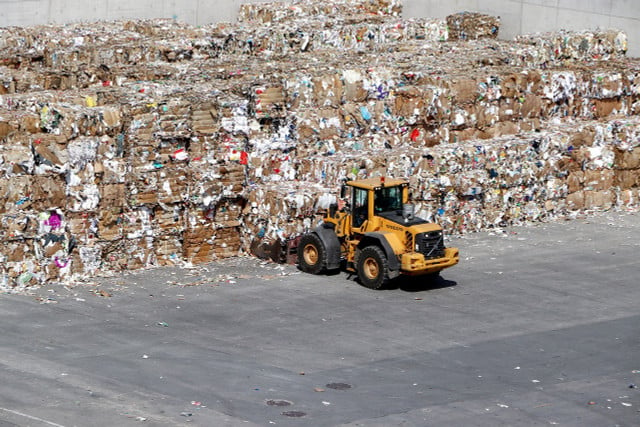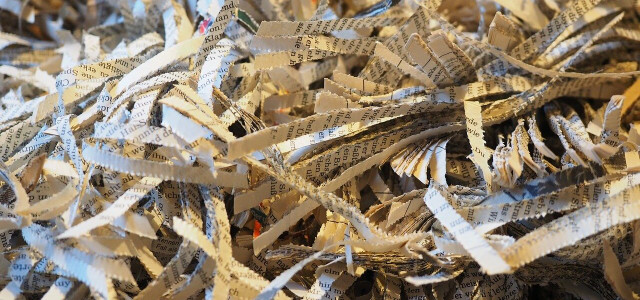In this article, we will discuss in more detail how paper recycling works, the problem with shredded paper and if you can recycle shredded paper, where you can take it to be recycled, alternatives to shredding paper, and how to best deal with it.
Around two-thirds of paper is recovered each year through paper recycling in the US. Paper recycling is great for the environment, supports carbon sequestration, and is used in the production of one-third of new paper.
By recycling paper, we not only clear up space in our homes but also retain the carbon in the paper fiber (originally absorbed from the tree from which it was produced) locked up for longer and out of the atmosphere – preventing it from producing methane as it breaks down.
Shredded paper has often been seen as a good solution for the disposal of confidential documents. But when it comes to recycling, it’s not short of logistical challenges with many recycling centers not accepting it at all.
How Paper is Recycled

(Foto: CC0 / Pixabay / WFranz)
Once collected, the paper from your recycling bin is transferred into a large recycling container at the recycling center where contaminants such as plastic, glass, or trash are removed. It is then sorted into types and grades and washed in soapy water to remove any inks, plastic film, glue, and staples.
Next, it is set aside until a mill needs it and then transferred for processing. In the mill large machines, called pulpers, shred the paper into small pieces which are then mixed and heated with water and chemicals to break them down into fibers.
Different materials can then be added to the pulp to create various new paper products, such as cardboard or newspaper. This paper slurry is then spread using large heated metal rollers into large thin sheets and left to dry. The paper is ready to be repurposed.
These paper fibers cannot however be recycled indefinitely, as they become shorter each time they are recycled. The average lifespan of paper fiber is around 5-7 cycles before new fibers must be added.
Can Shredded Paper be Recycled? The Problem.
Though paper is recyclable, shredded paper presents a unique challenge: the tiny shreds prove problematic for the sorting process and don’t as easily catch or stick to the gigantic screens of the paper mills. On the contrary, these pieces can get stuck in the machinery or cause a paper confetti explosion.
The other problem is that in order to process shredded paper properly, recycling center workers need to engage in the painstaking separation of the fibers by hand. Because of the extra work involved, shredded paper is often seen as less valuable than other types of recyclable paper. As a result, many recycling companies are loath to accept shredded paper for recycling.
Where Can You Take Shredded Paper to be Recycled?
Shredded paper is one of the biggest material acceptance variables in curbside recycling – so check with your local program before placing it in the recycling bin. Even if accepted by recycling centers or sanitation workers, it doesn’t mean they enjoy doing it.
Almost every city that accepts shredded paper will require that you bag in a clear paper bag before adding it to the recycling bin. Besides, it makes the process much easier for anyone taking it to the recycling center.
For large amounts of confidential documents, there are specialized shredded paper processing companies that work with businesses, local companies, and recycling organizations. Remember, however, to check for the appropriate license to handle this sensitive information and ask for a certificate of destruction once the recycling is complete.
How to Avoid Shredding Paper



(Foto: CC0 / Pixabay / Pexels)
Confidential documents or those containing personal or financial information should be shredded or at least partially destroyed before disposing of them.
There are eco-friendly options other than simply recycling your shredded paper. It can be used in a compost pile just like dry leaves or as bedding for small animals. Or you could use it as eco-friendly packing material.
Here are five options on how to avoid or reduce shredded paper:
1. Rip Off Sensitive Data
Rip the part of the paper that contains sensitive information and dispose of the rest of the paper intact. This makes life easier for the recycling team by reducing the amount of shredded paper produced.
2. Cut Off or Punch-Out Important Information
Use the likes of paper cutters, scissors, and paper punchers to destroy or conceal what is written on the paper. Might be quite time-consuming however for large amounts of paper.
3. Soak Paper in Water to Remove the Ink
Soak the documents in a water-filled container and leave to rest for a bit. Once the ink has become smudged and the documents unreadable, squeeze the water out of the paper and dispose of them in the recycling bin. This can also take a lot of time, effort, and water so only recommended for small amounts.
4. Cover Personal Information with a Permanent Marker
Use a permanent marker to remove personal information, such as a name or number, on a confidential document without shredding the document. The ink is easily removed in the recycling process.
5. Receive Your Mail Digitally
Why not minimize your environmental impact by getting all your bills digitally through the mail? By doing this you can reduce the amount of troublesome confidential paper you need to recycle.
How to Best Deal with Shredded Paper
Where possible look to produce less paper, opting to receive confidential letters such as bank statements online. When dealing with paper waste, try to avoid shredding where possible. Other options such as covering, soaking, or ripping where sensitive information, provides a good alternative.
Recycling is also not the only option for shredded paper. It can also be used at home as bedding for small animals, as the largely broken down carbon ingredient for compost, or as a sustainable packing alternative.
Read on:
- Precycling: How to Say No to Packaging Waste
- Save the Rainforest: 7 Things You Can Do
- Christmas Gift Wrapping Ideas: 10 Tricks to Waste Less Paper
Do you like this post?









